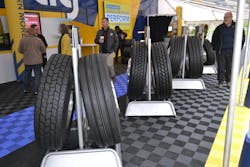Bridgestone's Higgs Talks Autonomous Trucks, Severe Service Retreads, GCR and More
While maintaining 44% share of the United States retreaded truck tire market, Bridgestone-Bandag has had a busy couple of years. In addition to introducing new tread products for severe service applications, last year Bridgestone staged a 29-city roadshow, titled “Fleets We Depend On,” to educate fleets about the advantages of using retreads.
In this interview, Eric Higgs, president, truck, bus and retread tires, U.S. and Canada, Bridgestone Americas Tire Operations, discusses the company’s efforts to promote retreading, how autonomous trucks could impact retreading and more.
MTD: What’s your take on the current state of the retread market as we prepare to enter the second quarter of the year?
Higgs: At Bridgestone, we are optimistic about the retread market. There is a lot of opportunity in the retread category for 2020 and beyond, as the practice of retreading creates value for fleets of all sizes. Fleets today are becoming more sophisticated and are willing to invest in business practices that maximize their investment. We anticipate that the retread market will remain healthy as fleet owners evolve their business models to include sustainable solutions that enhance profitability.MTD: What trends did you observe during the first quarter of 2020 and how did they impact Bridgestone’s retread business?
Higgs: The environment is highly competitive and original equipment manufacturers, suppliers and tire manufacturers are all developing and delivering new solutions to create more value for customers. One key trend shaping the future of mobility, as well as impacting retreading, are autonomous vehicles. Bridgestone is committed to making mobility more efficient for fleets and we believe retreading will be incredibly valuable for fleets of the future, which will utilize autonomous trucks. Without variations in driver behavior, tires on autonomous vehicles likely will wear more evenly, better protecting casings for retreading. These casings could conceivably last the entire life of an autonomous truck when coupled with retreading.
MTD: Bridgestone has introduced quite a few new, non-long haul Bandag retread products in recent years, including one for severe service applications and another for waste haul fleets. Do these products represent a new or renewed emphasis on niche applications?
Higgs: At Bridgestone, our new product strategy is rooted in anticipating and meeting our customers’ needs. Waste fleets and severe service fleets are challenged to perform in some of the toughest applications in the trucking industry. With frequent stops along residential and commercial routes each day, tires equipping waste fleet trucks often experience heat fatigue and faster wear. Punctures also can occur as these vehicles regularly drive through landfills. All of these factors can result in the removal of tires from a waste vehicle every three to six months, which can be costly. Retreading helps waste fleets maximize their tire investment. When it comes to severe service fleets, retreads can play a huge role in their overall tire management program.
MTD: As the U.S. truck tire retread market share leader, are you satisfied with the Bandag network’s geographic coverage?
Higgs: Bandag retreads are available through a large, far-reaching network of authorized dealers and retailers in the U.S. and Canada. We are constantly evaluating our distribution footprint to ensure we are fully leveraging our network to ensure fleet customers have access to the products they need when they need them.
MTD: Has the divestiture of certain GCR Tires & Service locations changed your retread strategy in any way? (Editor’s note: Bridgestone still owns and operates more than 70 GCR locations.)
Higgs: Our strategy remains the same. We believe the practice of retreading creates immense value for fleets of all sizes and we are committed to ensuring customers have access to high quality Bandag retreads. Our comprehensive retread distribution strategy encompasses our company owned GCR locations, as well as our many authorized Bridgestone and Bandag dealer partners across the U.S. and Canada.
MTD: Last year’s Bandag Fleets We Depend On roadshow was a first for Bridgestone. Did it move the needle in terms of increasing awareness about the benefits of retreading?
Higgs: During the roadshow, fleets were offered the opportunity to learn about retreading and the Bandag process, specifically, through an interactive exhibit, including a plant tour at many roadshow locations. The Fleets We Depend On campaign will continue this year through new content that will further advance the education and understanding of the value of retreading for fleets of all sizes – but especially small to medium-sized fleets. Bridgestone will also offer a Bandag “roadshow to-go” concept with assets and visuals that dealers can use to conduct their own Bandag roadshow at a location of their choice.
MTD: What impact – if any – are tariffs and ongoing trade tensions with China having on Bridgestone’s retread business in the U.S.?
Higgs: We continue to closely monitor the regulatory environment. The situation is very fluid, making it difficult to predict the future.
“Our focus is on educating fleets of all sizes about the many advantages retreads offer, helping them understand that retreads are a smart business choice in any market condition,” he says.
About the Author
Mike Manges
Editor
Mike Manges is Modern Tire Dealer’s editor. A 28-year tire industry veteran, he is a three-time International Automotive Media Association Award winner, holds a Gold Award from the Association of Automotive Publication Editors and was named a finalist for the prestigious Jesse H. Neal Award, the Pulitzer Prize of business-to-business media, in 2024. He also was named Endeavor Business Media's Editor of the Year in 2024. Mike has traveled the world in pursuit of stories that will help independent tire dealers move their businesses forward. Before rejoining MTD in 2019, he held corporate communications positions at two Fortune 500 companies and served as MTD’s senior editor from 2000 to 2010.

